 Many years ago it was thought that attic ventilation wasted energy. Many people make an effort to block the ventilation or opted to not install ventilation when their roofs were replaced. Since the 1980's, it was found that this practice can actually increase energy costs! Also, improper ventilation can
Many years ago it was thought that attic ventilation wasted energy. Many people make an effort to block the ventilation or opted to not install ventilation when their roofs were replaced. Since the 1980's, it was found that this practice can actually increase energy costs! Also, improper ventilation can
- Decrease the life of your shingles
- Ruin your attic insulation
- Damage the roof's framing components
- Contribute to mold growth
 One of the most frequent questions we get on older homes is, "The roof never had vents, why do we need it now?" Most old homes originally had cedar shakes or cedar shingles. These homes had a roof deck constructed using lap boards or ship boards that had about an inch gap between them. This was done because the cedar roof needed a way to dry out.
One of the most frequent questions we get on older homes is, "The roof never had vents, why do we need it now?" Most old homes originally had cedar shakes or cedar shingles. These homes had a roof deck constructed using lap boards or ship boards that had about an inch gap between them. This was done because the cedar roof needed a way to dry out.
Those gaps allowed air to flow between them through the shingles. It worked great! But eventually, those roofs had asphalt paper laid over the top followed by a layer (or two) of asphalt shingles. This sealed up the natural ventilation leaving no way for the air to flow out of the attic space.
Winter Time Problems
Most people don't ever venture into their attics, Especially in winter. We inspect hundreds of homes each year and here are some of the things that can happen during the winter months when you have poor ventilation. Make sure to check out our Ice Dam Article!
The heat and moisture from your home naturally migrates to your attic. If this isn't properly vented, the moisture will condense (and even freeze) on cold surfaces in your attic. Eventually, this moisture will melt, soaking your attic insulation and reducing its effectiveness. It can also contribute to mold growth that can affect your family's health.
 |
|
 |
Mold Growth
 Mold typically won't grow when the temperatures are below 32 degrees F or when the humidity levels are below 65%. But there is chance your attic can be an ideal spot for mold to really thrive. Your roof and some insulation provides a great food source!
Mold typically won't grow when the temperatures are below 32 degrees F or when the humidity levels are below 65%. But there is chance your attic can be an ideal spot for mold to really thrive. Your roof and some insulation provides a great food source!
 Another source of moisture than can contribute to mold growth comes from kitchen and bathroom fans that vent into the attic space and not to the exterior of your home. In the picture to the right, the duct attached to the bathroom vent that was directed to the soffit but not attached to any exterior vent. The heat and humidity rose from the end of the duct and rotted out the roof. This is why positive ventilation is important!
Another source of moisture than can contribute to mold growth comes from kitchen and bathroom fans that vent into the attic space and not to the exterior of your home. In the picture to the right, the duct attached to the bathroom vent that was directed to the soffit but not attached to any exterior vent. The heat and humidity rose from the end of the duct and rotted out the roof. This is why positive ventilation is important!
Spring Time Problems - Check for Birds!
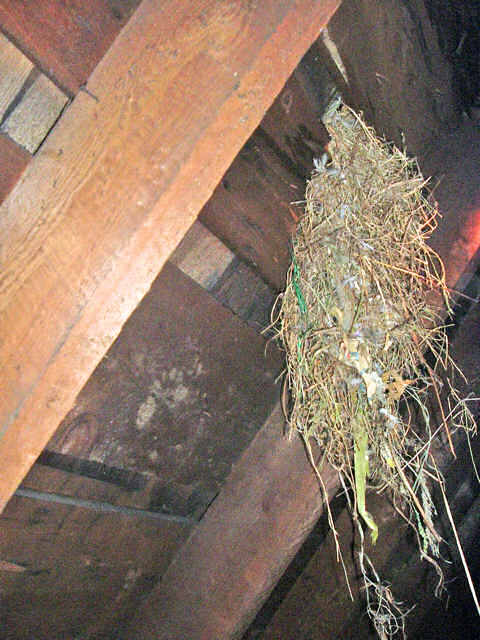 Many times, our feathered friends love the shelter and warmth that Roof Louvers provide for their new family. Unfortunately, the nests can cause problems. Not only do the nests block the vents, but birds can also transmit many diseases that are not healthy for your family!
Many times, our feathered friends love the shelter and warmth that Roof Louvers provide for their new family. Unfortunately, the nests can cause problems. Not only do the nests block the vents, but birds can also transmit many diseases that are not healthy for your family!
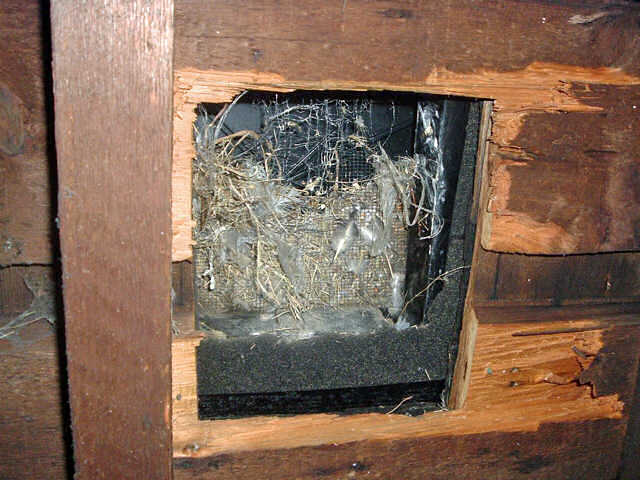 Peek your head into the attic and take a look at the vents. If you see something similar to the picture to the right, you will need to replace your screens. Make sure to use metal screening (Hardware Cloth) with at 1/4" spacing. Staple this to the underside of the roof.
Peek your head into the attic and take a look at the vents. If you see something similar to the picture to the right, you will need to replace your screens. Make sure to use metal screening (Hardware Cloth) with at 1/4" spacing. Staple this to the underside of the roof.
Fiberglass screening can be easily torn (see left). Make sure you wear a respirator, eye protection, and gloves when you do the clean-up! You will be stirring up dust and feces. Take a garbage bag with you to clean up any debris. Just don't overfill it because it still needs to fit through the scuttle hole!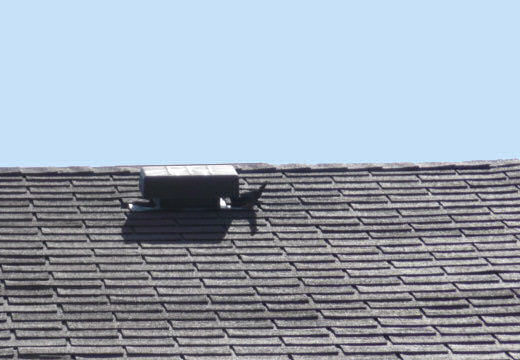
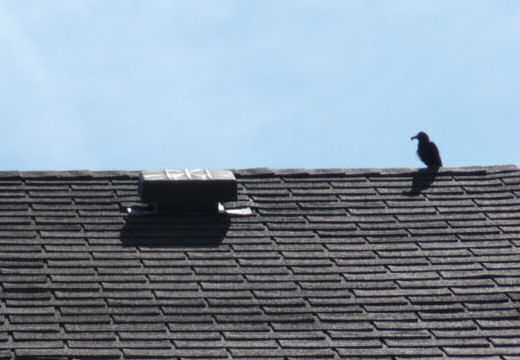 Birds usually return to their same nesting area each year. One method to help discourage this revisiting is to hang a small nylon stocking filled with moth balls under each attic louver in late winter before they come back. Otherwise, you should wait until the offspring are able to fly away. The pictures above were taken during an actual home inspection. The offspring were heard chirping noisily when the food arrived!
Birds usually return to their same nesting area each year. One method to help discourage this revisiting is to hang a small nylon stocking filled with moth balls under each attic louver in late winter before they come back. Otherwise, you should wait until the offspring are able to fly away. The pictures above were taken during an actual home inspection. The offspring were heard chirping noisily when the food arrived!
Summer Time Problems
 Temperatures in your attic during the summer can easily exceed 160 degrees F. This heat can penetrate your ceilings contributing to higher cooling costs. It also accelerates the aging process of your wood rafters and trussed weakening them to the point where they can begin to fail. A typical condition is called Honeying. You can see this condition on the rafters and is caused by the high temperatures that literally bake the sap out of the wood.
Temperatures in your attic during the summer can easily exceed 160 degrees F. This heat can penetrate your ceilings contributing to higher cooling costs. It also accelerates the aging process of your wood rafters and trussed weakening them to the point where they can begin to fail. A typical condition is called Honeying. You can see this condition on the rafters and is caused by the high temperatures that literally bake the sap out of the wood.
 Any defects that are naturally part of the lumber like knots, etc usually can handle the stresses of the home. But over years of exposure to these high temperatures can eventually weaken these supporting members to the point where they can fail. That's why controlling the temperature is so important. Properly ventilating you attic will most certainly help.
Any defects that are naturally part of the lumber like knots, etc usually can handle the stresses of the home. But over years of exposure to these high temperatures can eventually weaken these supporting members to the point where they can fail. That's why controlling the temperature is so important. Properly ventilating you attic will most certainly help.
How Ventilation Works - Convection
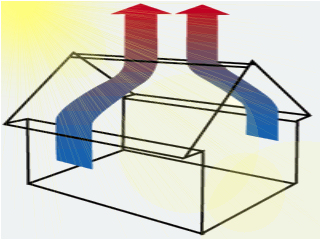 Proper ventilation provides a continuous flow of air from the outside through your attic space. This protects your insulation and reduces the load on your heating and cooling systems. Air enters you home either from the soffits (your overhang) and then exits out of either a roof louver or a ridge vent.
Proper ventilation provides a continuous flow of air from the outside through your attic space. This protects your insulation and reduces the load on your heating and cooling systems. Air enters you home either from the soffits (your overhang) and then exits out of either a roof louver or a ridge vent.
The process happens from natural convection. During the day the sun heats your roof and the air in your attic. As the warm air rises, it draws in cooler air from the vents in your eves. Half of the vented area should be on the high side and the other half on the low side.
Cross Ventilation
 Some home may only have a gable vent or two. We've inspected some homes where these vents have been totally blocked from the inside and unless someone takes a trip into the attic you may never know it. If you live in a home with louvers near the peak of the roof, you should check them out or give us a call and we will do it for you.
Some home may only have a gable vent or two. We've inspected some homes where these vents have been totally blocked from the inside and unless someone takes a trip into the attic you may never know it. If you live in a home with louvers near the peak of the roof, you should check them out or give us a call and we will do it for you.
This type of ventilation isn't as effective as convection mentioned above. It mostly relies on the prevailing winds to ventilate the attic space. Remember the cedar roofs? Well, this was the opening that was built into the home to provide air to dry out those cedar shingles.
Types of Ventilation Products
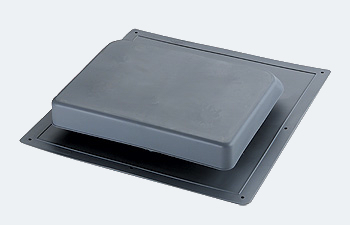 The most common vents are roof louvers. They are those little square boxes you can see on the roofs of many homes. Most of these types are 9 in x 9 inches and provide about 50 square inches of free ventilation area.
The most common vents are roof louvers. They are those little square boxes you can see on the roofs of many homes. Most of these types are 9 in x 9 inches and provide about 50 square inches of free ventilation area.
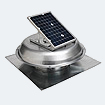 There are many new products coming into the market that not only improves your attic ventilation but also is "Green" Check out this solar powered ventilator!
There are many new products coming into the market that not only improves your attic ventilation but also is "Green" Check out this solar powered ventilator!
 Ridge vents are probably the most popular type of a high venting product that is in use today. It's very effective but in our climate you need to make sure it's designed to be "snow proof"
Ridge vents are probably the most popular type of a high venting product that is in use today. It's very effective but in our climate you need to make sure it's designed to be "snow proof"
How Much Ventilation do you Need?
The FHA, VA, and HUD requires 1 square foot for every 300 square feet of attic space. Figuring your ventilation requirements requires a little bit of simple math. Just follow this example and you can most certainly do it yourself!Assume you've selected a 9" roof louver (50 sq inches each) and 8 in x 6 in under eves soffit vent (56 sq inches each)
1. Calculate the square footage of your attic space
- Length (in feet) x Width (in feet)A 32ft x 42 ft house with a 10 ft x 20 ft addition
- 32 ft x 42 ft = 1,344 sq ft
- 10 ft x 20 ft = 200 sq ft
- 1,344 + 160 = 1,544 sq ft
2. Calculate the free area
- Use the 1/300 rule
- 1,544 sq ft ÷ 300 = 5.147 sq ft
- Convert square feet to square inches
- 5.147 x 144 = 741.1 square inches
- 741.1 ÷ 2 = 370 square inches on the high side
- 741.1 ÷ 2 = 370 square inches on the low side
3. Select a ventilation product that meets your needs
You will need to substitute the square inches of vent area for the product you select in the formulas below.
- High Vents
- 370 ÷ 50 = 7 high vents
- Low Vents
- 370 ÷ 56 = 7 low vents



